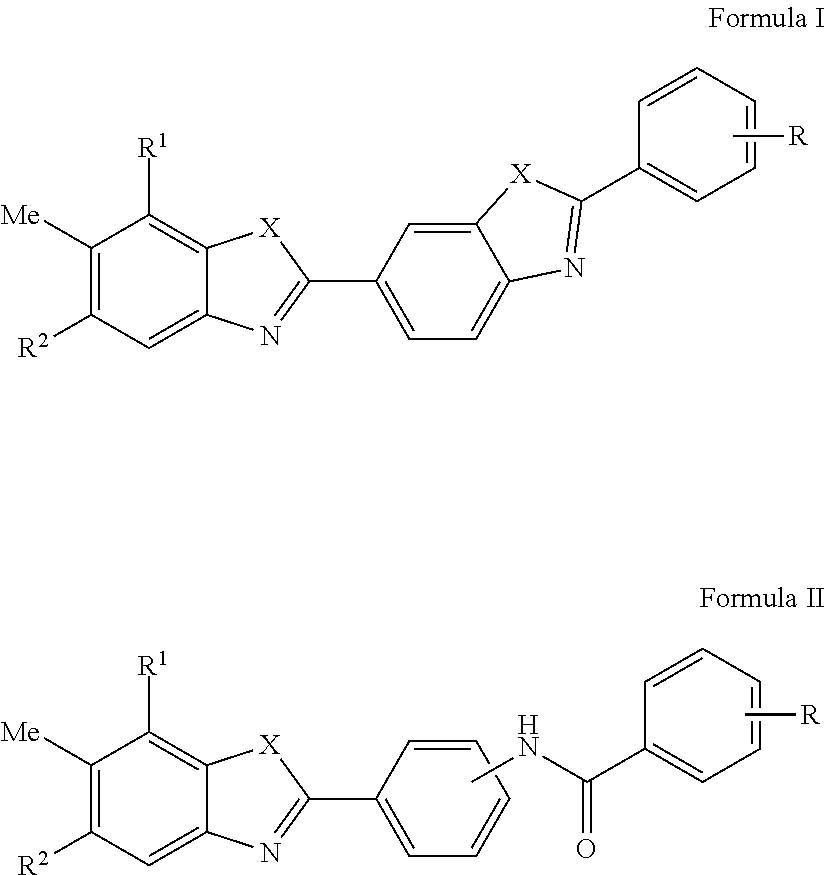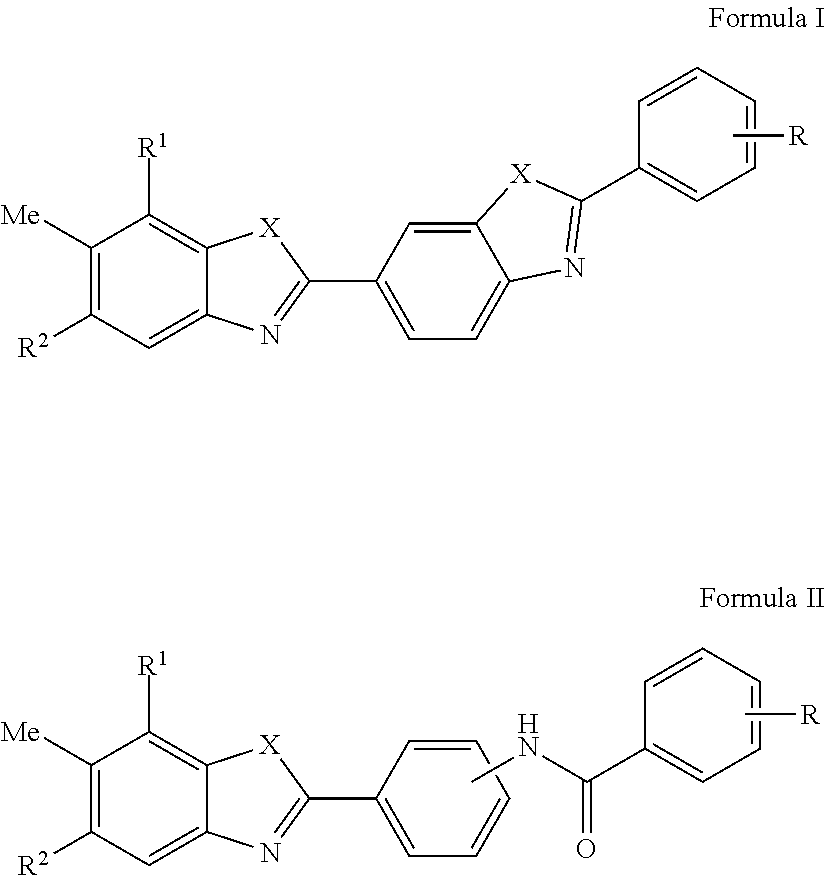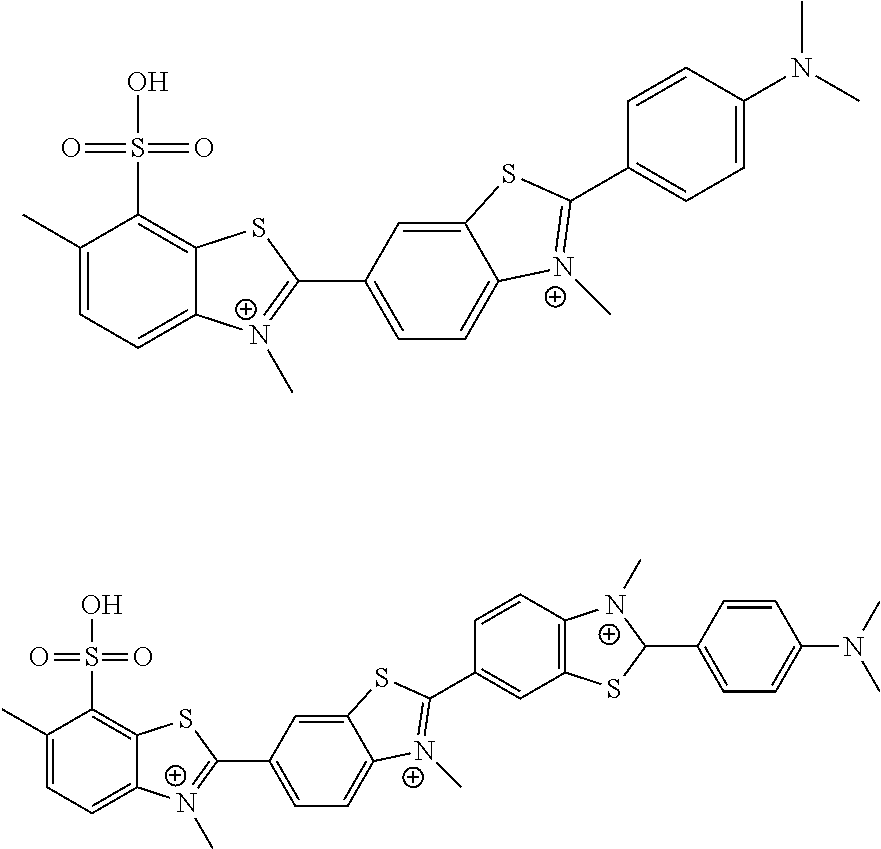HCV Helicase Inhibitors and Methods of Use Thereof
a technology of helicase inhibitors and hcv, which is applied in the field of hcv helicase inhibitors, can solve the problems of poor treatment tolerance, high cost, and ineffectiveness of new therapies, and many patients still fail to tolerate new therapies
- Summary
- Abstract
- Description
- Claims
- Application Information
AI Technical Summary
Benefits of technology
Problems solved by technology
Method used
Image
Examples
example 1
Experimental Procedures
[0047]Materials.
[0048]Thioflavine S and primuline were purchased from Sigma and MP Biomedicals, respectively. The Mechanistic Diversity Library was obtained from the National Cancer Institute. All other reagents were purchased from commercial suppliers and used as received. Methylene chloride, acetonitrile, toluene, ethyl ether and THF were dried by being passed through two packed columns of anhydrous, neutral alumina prior to use. HPLC / MS analysis was carried out with gradient elution (5% CH3CN to 100% CH3CN) on an AGILENT 1200 RRLC with a photodiode array UV detector and an AGILENT 6224 TOF mass spectrometer. Compound purity was determined using RP HPLC and was measured on the basis of peak integration (area under the curve) from UV / vis absorbance (at 214 nm), and compound identity was determined on the basis of exact mass analysis. All compounds used for biological studies have purity>95% except for the following compounds: P3 (89.2%), P4 batch 2 (85.6%), 6...
example 2
Screen for HCV Helicase Inhibitors
[0080]To identify HCV helicase inhibitors, the MBHA was first used to screen the National Cancer Institute Developmental Therapeutics Program's mechanistic set library. In total, 827 compounds (at 20 μM) were screened using a MBHA with a DNA substrate (Table 1). Compounds were ranked by their ability to inhibit HCV helicase-catalyzed DNA unwinding as calculated from Equation 1.
TABLE 1NSC#Inh. (%)Int.* (Ratio)NSC#Inh. (%)Int.* (Ratio)NSC#Inh. (%)Int.* (Ratio)363998138.70.17658494 6.70.95640638 −7.00.93175493136.80.572670336.71.0456737 −7.21.12273829105.00.262930156.70.96635833−7.30.9334391100.60.24310618 6.61.17376791−7.31.086918799.20.221111196.31.16631152−7.30.943493189.20.906599996.10.44 682769−7.30.967084584.40.591466046.11.1234757−7.40.9815489079.40.29174176 6.01.04624953−7.50.9064019976.40.706297385.90.97674495−7.50.9864050671.10.911165355.90.9398447−7.61.0533776670.00.6547285.91.07163443−7.60.888556168.80.906353265.91.11601101−7.80.977194867.5...
example 3
Activity of Thioflavine S Components
[0084]Thioflavine S is not a single compound but rather is a heterogeneous dye prepared from another yellow dye called primuline by successive methylation and sulfonation reactions (Conn's Biological Stains, 10th Edition). Primuline inhibited HCV helicase in MBHAs with similar potency as thioflavine S (10±4.6 μM). To better understand how these dyes inhibit HCV helicase, both mixtures were separated using preparative HPLC or combination of normal phase silica gel chromatography and reverse phase preparative HPLC.
[0085]The structure associated with the dye thioflavine S is not reported consistently or left intentionally vague, creating confusion over the chemical identity of the screening hit. For instance the MSDS (Sigma Aldrich) for thioflavine S describes the compound only as “methylated, sulfonated primuline base”. In the NCI and Pubchem online databases, thioflavine S (NSC71948, SID550242) is reported as a mixture of methylated benzothiazoles ...
PUM
 Login to View More
Login to View More Abstract
Description
Claims
Application Information
 Login to View More
Login to View More - R&D
- Intellectual Property
- Life Sciences
- Materials
- Tech Scout
- Unparalleled Data Quality
- Higher Quality Content
- 60% Fewer Hallucinations
Browse by: Latest US Patents, China's latest patents, Technical Efficacy Thesaurus, Application Domain, Technology Topic, Popular Technical Reports.
© 2025 PatSnap. All rights reserved.Legal|Privacy policy|Modern Slavery Act Transparency Statement|Sitemap|About US| Contact US: help@patsnap.com



